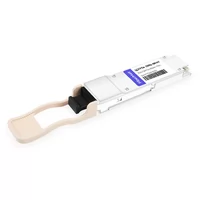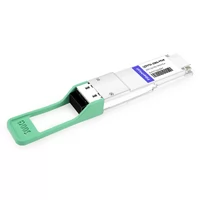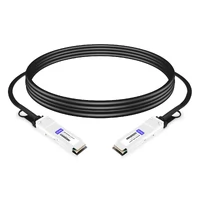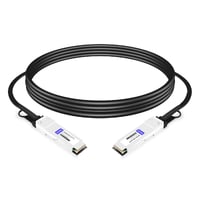The requirements of networks are increasing at an alarming rate as a result of the rapid changes experienced in technology today. QSFP56 (Quad Small Form-factor Pluggable 56) transceivers and modules are an enormous step forward for high-speed data transmission; they perform better, use less energy, and can be expanded more quickly. This manual seeks to explain everything there is to know about QSFP56 technology by providing information on its features, advantages, uses, and ways of implementation. Whether you work as a network engineer or an IT expert, or maybe you’re just interested in knowing what’s new with optical transceivers lately, this piece will give you all that is necessary for keeping up within the realm of high-speed networking.
Table of Contents
ToggleWhat is a QSFP56 Transceiver?
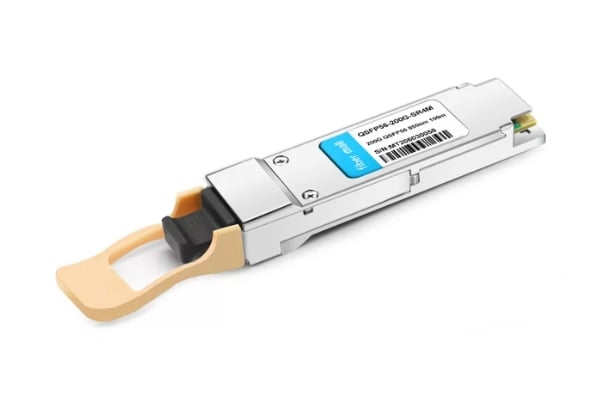
Overview of QSFP56
A QSFP56 transceiver is a small, hot-swappable optical module for high-speed data communication networks. It is compatible with 200 Gigabit Ethernet, which makes it perfect for businesses and data centers that want to increase bandwidth and decrease latency. The QSFP56 transceiver uses the same form factor as the QSFP but can achieve up to 50 Gbps per channel with PAM4 (Pulse Amplitude Modulation) technology. This not only boosts speed but also remains backward-compatible with previous generations of QSFP hardware, so integration is simple and scalability assured.
Functions and Applications
The QSFP56 is a crucial component in high-speed networking environments. Basically, this device allows for the sending and receiving of data over optical fiber cables by converting electrical signals into light signals, thereby enhancing faster and more reliable communication. The QSFP56 transceiver can transmit data at 50 Gbps per channel using PAM4 modulation, thus aggregating up to 200 Gbps within a single module. This feature is essential in meeting the data throughput requirements for current data centers, cloud computing services, and enterprise networks where 100G QSFP28 and 200G QSFP56 are widely deployed.
Data Center Interconnects
Within data centers (DCs), one uses a QSFP56 transceiver to interconnect servers or storage devices or between servers and storage systems. They help achieve low latency and high bandwidth, which are necessary for virtualization and big data analytics, among other things like real-time streaming applications that need such resources. Reports show that if businesses adopted these modules, they could save up to 40% power consumption compared with old models while still delivering better performance.
High-Performance Computing (HPC)
In High-Performance Computing environments (HPC), you will find many supercomputers connected together through fast networks created using many QSFP56 modules so that they operate at very high speeds with low latencies. These types of networks allow quick sharing of information between different parts of the system – something which is needed when doing heavy computations or scientific research simulations requiring parallel processing capabilities across large computational clusters where each node may compute different parts of the overall simulation task but requires results from all other nodes before proceeding further towards completion stage(s)). Moreover, supporting a 200 Gb/s rate greatly improves computer efficiency, making possible much more detailed outcomes faster, too.
Enterprise Network Upgrades
For companies upgrading their network infrastructure, there’s no better choice than using these transceivers since they offer scalability options required during growth phases. It is also backward compatible with previous types, thus making it possible for an enterprise to upgrade performance without necessarily overhauling the entire network system. Therefore, this means that QSFP56 becomes a cost-effective way of efficiently increasing an organization’s network capability and overall performance levels.
Cloud Services
In cloud service provision, speed matters a lot, especially when dealing with huge amounts of data traffic from different sources at once—this is where the high speeds and capacities provided by QSFP56 come into play. These devices enable quick resources and service allocation, which helps maintain good-quality service delivery within such cloud applications. Besides, handling up to 200 Gbps rates ensures that these networks can scale anytime as required due to their growing demand.
To sum it up, we cannot do away with the versatility or high performance of QSFP56 transceivers because they are so useful in various areas requiring very fast networks. Whether you need them for DC interconnects, HPC needs, EN upgrades, or even CS purposes – just know that using these gadgets will always give you more bandwidth than before, thereby lowering latencies as well as reducing power consumption during operations, thus becoming key parts of any modern optical networking solutions today.
Form Factor and Compatibility
The QSFP56 transceivers work with the Quad Small Form-factor Pluggable (QSFP) form factor that allows for their small and convenient use in network equipment. These transceivers are compatible with previous versions of QSFP and QSFP+ ports, making it easy for users to upgrade without necessarily changing a lot on the hardware infrastructure already in place. This especially benefits data centers and businesses that want to increase their network capacity step by step.
Additionally, modules of this kind have hot-pluggable abilities, so they can be installed or replaced without powering down any device connected to them, therefore reducing interruptions while managing networks at peak performance levels. It boosts operational effectiveness, too, since it supports the dynamism necessary for high-performance network environments.
What are the Differences Between QSFP28 vs QSFP56?
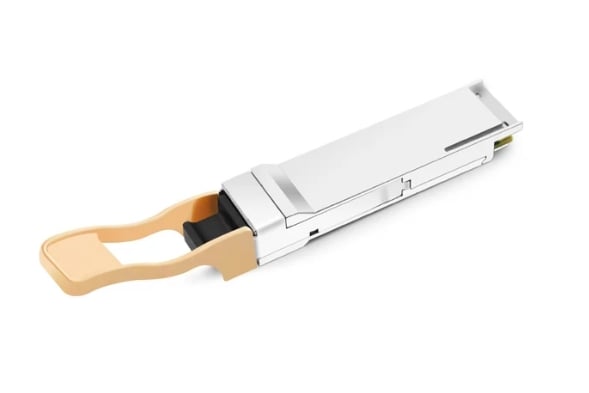
Speed and Data Rate Comparison
What separates QSFP28 from QSFP56 is the speed and data rate capacity. By using four lanes, each having 25 Gbps, QSFP28 transceivers support up to 100 Gbps of data rates. For different network needs, both QSFP28 and QSFP56 modules have options that are flexible enough. Such features enable these products to be used in many high-speed networking applications, such as enterprise environments or data centers where strong amounts of data must be moved quickly without being too complicated or costly.
On the other hand, the QSFP56 transceiver supports higher speeds with a maximum limit of 200 Gbps. This is achieved through four lanes each carrying 50 Gigabytes per second (Gbps) and utilizing more advanced modulation techniques like PAM4 (Pulse Amplitude Modulation 4-level). Therefore, it can be said that the increased capability for transmitting information at faster rates makes this product suitable for use in intensive bandwidth consumption fields, which require low latency and easier expansion, including but not limited to HPCs (high-performance computing) systems and next-gen cloud services, among others.
In conclusion, although they play crucial parts in optical networks’ functioning, Qsfp-56 wins over Qsfp-28 because it offers higher speeds coupled with greater data transfer capacities required by modern-day high-speed network infrastructures.
Electrical Interface Specifications
Both networking devices can integrate with QSFP28 and QSFP56 transceivers at the hardware level, but their electrical interface specifications are different because they work at different speeds and process data rates differently.
QSFP28 Electrical Interface:
With a total of 100 Gbps, QSFP28 employs a 4×25 Gbps electrical interface. It is designed according to IEEE standards like IEEE 802.3bj which ensures compatibility with Ethernet and Fiber Channel applications. NRZ (Non-Return to Zero) is commonly used as a signaling method for this specification since it helps signal integrity over shorter distances while simplifying processing requirements.
QSFP56 Electrical Interface:
In terms of 200G QSFP56 transceiver applications alone, there is a need for additional capabilities through the utilization of an improved 4×50 Gbps electrical interface by QSFP56. Higher data rates may be supported by PAM4, which is a more complex modulation technique than any other thing used before, and it could have been achieved without jeopardizing signal fidelity. In other words, PAM4 doubles the capacity by representing two bits per symbol instead of just one, thus underpinning IEEE standard 802.3cd that caters to high-bandwidth data transfers. This means such refined ways of communication would enhance broader bandwidth coverage along with increased efficiency. However, there might also be a need for more sophisticated error correction methods aimed at ensuring integrity during transmission.
The above-given descriptions of these two kinds of optical modules tell us what each one does best and how well it does so vis-à-vis its peers within the same category in terms of performance levels and technological advancements made thereof. While NRZ being employed by QSF28 can work comfortably at 100Gbps, the PAM4-based approach adopted by QSF56 enables achievement up to 200Gbps, which makes them suitable for diverse networking environments depending on demand for bandwidth or infrastructure required to support them.
Backward Compatibility
Using fresh systems is only possible if they are compatible with the old ones, known as backward compatibility. Typically, QSFP56 modules can work with QSFP28 ports used in older devices; nonetheless, this relies on the specific transceiver and system design being considered. Comparing QSFP56 and QFSP28 when making network plans is important. A QSFP56 transceiver operates at a lower data rate (100 Gbps) than what it was designed for (200 Gbps) when plugged into a QSFP28 slot but still maintains its performance by NRZ modulation scheme. The NRZ schemes used here enable service providers to carry out incremental infrastructure upgrades without changing everything at once or disrupting service delivery while migrating towards higher-speed networks.
How Does QSFP56 Compare to QSFP-DD?
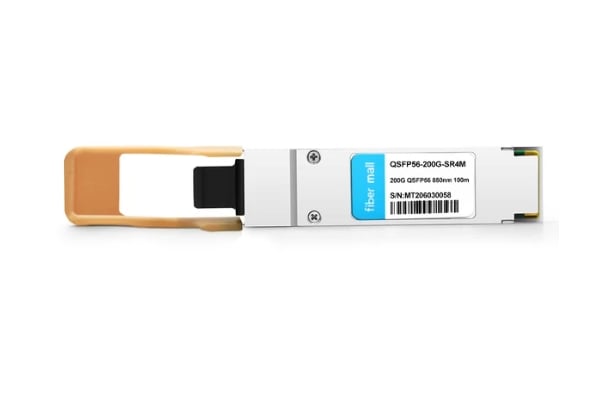
Technological Advancements
QSFP56 and QSFP-DD (Quad Small Form-factor Pluggable – Double Density) were created to address the contemporary need for more bandwidth in data centers and high-performance computing environments. To reach 200 Gbps over four lanes, QSFP56 is based on QSFP28 but utilizes PAM4 (Pulse Amplitude Modulation). On the other hand, the eight-lane configuration of QSFP-DD allows for much higher capabilities than this; it doubles them up to 400Gbps per second, which is why we should analyze qsfp-dd versus 200g qsfp-dd when it comes to fast-acting needs.
Physical form factor and electrical interface are among some key disparities between these two products: while adding rows of electric contacts that support faster transmission rates, QSF DD uses hybrid connectors so as not to hamper its compatibility with existing infrastructures based on QSP modules also at the same time allowing for easy migration from one type into another if necessary. In addition, the heat dissipation management system in QSFPDD is upgraded compared to those implemented within QSFP+ devices since they consider the power consumption increase caused by higher data throughput, thus ensuring reliability during operation.
In conclusion, although it still relies on PAM4 tech to deliver two times more bits per second than its predecessor, this only means that the double-density architecture used here sets a new bar for next-generation network demands, where 400gbps becomes a reality, unlike previous versions, which limited themselves to 200Gbps, which was not enough.
Use Cases in Data Centers
Data centers rely on QSFP56 and QSFP-DD modules for fast, high-capacity, low-latency connections. For instance, where moderate to high data rates are needed but the existing QSFP infrastructure is still wanted, making the upgrade process easier, spine-leaf architectures, systems for high-frequency trading, and clusters of high-performance computing requiring 200 Gbps connectivity, among others, can benefit from QSFP56.
On the contrary, when it comes to environments demanding the maximum possible bandwidth, such as large-scale cloud service providers, content delivery networks (CDNs), or telecom data centers, one should consider using QSFP-DDs. With a 400GBps capacity, this module becomes essential in future-proofing any organization’s operation concerning speed since it allows ultra-fast data transfer rates, which could accommodate exponential traffic growth brought about by emerging technologies like AI, IoT, and 5G. However, much more efficiency needs to be unlocked while considering scalability within these challenging scenarios where performance is everything, thus calling upon the availability of 400G QSFP56-DD modules.
Comparing 200g QSFP56 to 400g QSFP-DD
The main difference between QSFP56 and QSFP-DD is the highest data capacity. QSFP56 can reach up to 200 Gbps, which is made possible by PAM4 technology. This implies that it can be used for applications with higher bandwidths while still being compatible with systems based on QSFP. For this reason, it provides a seamless upgrade path for infrastructures that require more speed without changing everything.
On the other hand, QSFP-DD or Double Density is designed to deliver better performance at 400Gbps. It achieves this through its architecture that doubles density, thus enabling the accommodation of additional electrical lanes like the 400G QSFP56-DD design. Next-generation high-capacity data centers are supported by QSPF-DD, which can scale up according to the needs of cloud providers on a large scale, telecom operators, and other industries needing ultra-high bandwidth together with low latency while ensuring future rate requirements brought about by advancements in AI, 5G, and IoT.
In summary, regarding current high-performance needs meeting and system compatibility considerations, it’s good to opt for QSPF56. However, suppose one wants their data center equipped with more bandwidth and capacity to prepare for tomorrow’s demands. QSPFDD should be selected in that case, as this will pave the way toward next-generation network performance and scalability.
What are the Key Applications of QSFP56 Modules in Data Centers?
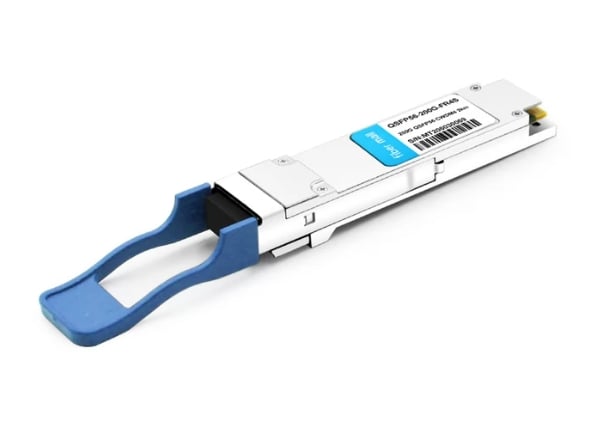
High-Speed Ethernet Connections
In present-day data centers, QSFP56 modules are necessary for high-speed Ethernet connections. These can enable the establishment of 200 Gigabit Ethernet links needed for applications and services that involve a lot of data. The main uses of QSFP56 modules include bringing together many 25G or 50G connections to improve network performance and decrease latency. Moreover, they also support fast uplinks between core switches and distribution switches so that there is a smooth flow of information across the whole data center. Furthermore, QSFP56 modules enable the integration of future hardware without any challenges, allowing flexibility in scaling up data centers while optimizing infrastructure investment through backward compatibility maintenance.
Interoperability with Existing Networks
The ultimate goal of QSFP56 modules is to facilitate easy integration with already-in-place network structures. These gadgets are also designed so that they can be used interchangeably with QSFP28 interfaces, which means that one does not need to change anything or make any major modifications when transitioning from 100G links to 200G links. Another thing about them is that they follow universally accepted standards, so it becomes very simple for them to work together with legacy systems as well as current high-speed connections, thus making them an ideal choice for upgrading data centers. Furthermore, these devices perform well with common network topologies like leaf-spine architectures, which ensures scalability and performance improvement reliability without interfering with existing network operations.
Impact on Data Center Performance
According to leading sources, data centers can achieve higher speeds and lower delays necessary for managing data-driven tasks through the use of QSFP56 modules. These modules permit faster information transfer rates that will enhance networks’ overall throughput and efficiency. By enabling 200G Ethernet links, QSFP56 modules facilitate combining many connections with lower speeds, thus reducing traffic jams and optimizing the flow of information. In addition to supporting high levels of port density increase, their advanced designs also promote energy conservation, lowering operational expenses while minimizing environmental impact. Such benefits contribute to making stronger and more scalable infrastructures within data centers to meet upcoming technological needs while safeguarding future investments.
Understanding 200g QSFP56 Optical and DAC Cables
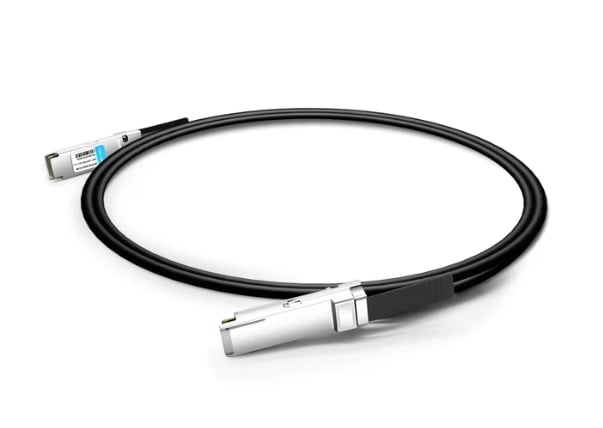
Optical Module Characteristics
Numerous significant attributes are presented by the 200G QSFP56 optical modules for high-performance data center environments. Firstly, signaling technologies like PAM4 (Pulse Amplitude Modulation) have been used in these modules to enable higher data transfer rates through a single optical fiber. Secondly, they usually work with various distances: short-reach configurations on multimode fibers (up to 100 meters) or long-reach solutions on single-mode fibers (up to 10 kilometers or more), depending on what the infrastructure requires.
Another important feature is their adherence to recognized industry standards such as IEEE and MSA (Multi-Source Agreements). Doing so allows them to interoperate with any current networking equipment and make upgrades smooth. Most 200G QSFP56 optical modules incorporate Digital Diagnostic Monitoring (DDM), which gives the ability to monitor different parameters of an optical transceiver in real time, including temperature, voltage, laser bias current, and optical output/input power, among others.
Additionally, energy efficiency is one area in which these optical modules really stand out. The design improvements done in QSFP56 modules lower power consumption per bit, thus cutting down operational costs and making data centers greener. Besides being hot-swappable, it is designed to allow easy maintenance and upgrading without interfering with network operations. All these properties combined together make them perfect for use when there is a need to expand bandwidth capacity while still keeping robustness in operation within data centers that are already efficient enough.
Direct Attach Copper (DAC) Cable Features
Direct Attach Copper (DAC) cables are a cheap and cheerful way to transmit data over short distances in data centers and high-performance computing environments. They’re made up of twinaxial copper cable and transceiver modules connected permanently at each end as one single fixed assembly. This means they can support very fast data transfer rates – 10Gbps, 25Gbps, 40Gbps, and even 100Gbps – so they’re good for applications that need quick and steady links.
The main reason people use DAC cables is they have such low latency, which is vital if you’ve got applications that need to exchange data rapidly. Also the twinax design gives them good signal integrity because of the robust shielding and low electromagnetic interference (EMI). They’re technically better than other options too; DAC cables use less power than fibre optic equivalents so they’re more energy efficient.
DAC cables don’t need any extra optical components like optical transceivers do, so they save time on installation and money on buying extra parts. Plus, DAC cables can be hot-swapped and are plug-and-play, which makes them easy to deploy and maintain without causing network downtime. These things mean that DAC cables are perfect for short-distance high-speed interconnects where you want the most reliable performance out of your modern data center environment.
Choosing Between Optical and Copper Solutions
When deciding between copper and optical solutions, several factors must be taken into account, such as distance requirements, bandwidth needs, and environmental conditions. Fiber optic cables or optical solutions are the best for long-range data transmission with high bandwidth capabilities. They can support over 100Gbps data rates while incurring almost no signal loss and being immune to electromagnetic interference (EMI), thus making them perfect for large-scale data centers and telecommunications infrastructure.
On the other hand, within a data center or between adjacent racks, one should opt for direct-attach copper (DAC) cables used for short-distance applications. These cables provide lower latency, cost-effectiveness, and less power consumption than their optical counterparts. Furthermore, installation is much easier since copper allows you to plug and play, which also reduces maintenance efforts, hence lowering operational costs.
Finally, it all comes down to what exactly your network needs are; if you want shorter distances covered at lower prices, go for DAC copper cables, but when you need to cover greater distances along with higher data rates, optical solutions will be more appropriate.
What are the Standards and Specifications for QSFP56?
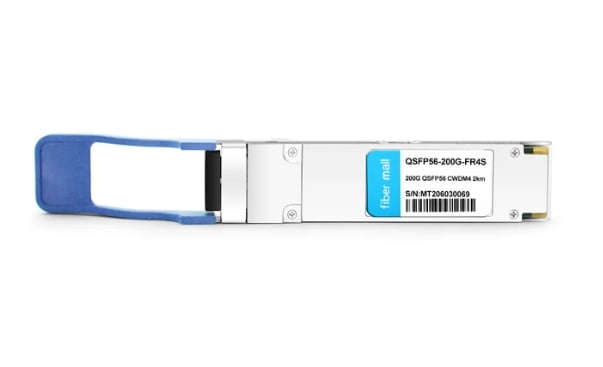
Compliance with IEEE 802.3bs
The QSFP56 standard was designed in compliance with the IEEE 802.3bs specification, which defines the physical layer and management parameters for 200 Gb/s and 400 Gb/s Ethernet. It meets all these requirements by ensuring that modules can handle data speeds up to 200 Gbps through efficient signal transmission and minimal error rates. To promote compatibility between various types of networking equipment, this standard lays down certain rules regarding electrical interfaces, modulation schemes, and physical media, among other things. Therefore, any device manufactured following this guideline will be able to work with those produced by other vendors, thus creating an environment where different devices can coexist harmoniously as parts of one network system capable of supporting high-speed dense data communication.
QSFP-DD MSA Overview
The Multi-Source Agreement (MSA) QSFP-DD (Quad Small Form-Factor Pluggable Double Density) sets forth the guidelines regulating a double-density, high-speed interface for modern data communication networks. It can support up to 400 Gbps of data throughput with its eight-lane electrical interface; each lane has a capacity of 50 Gbps. This standard achieves backward compatibility with existing QSFP modules and twice as many connections in the same area while improving overall bandwidth efficiency. The MSA defines mechanical, electrical, and thermal parameters that ensure reliable operation under high-density environments – such as data centers or enterprise networks. Interoperability among different devices is enabled by adhering to QSFP-DD MSA, thus making it vendor-neutral and scalable for next-generation networking needs.
Key Specifications and Parameters
- Data Rate: The QSFP-DD allows a data rate of 400 Gbps aggregate. This is achieved through eight roads, each transmitting at 50 Gbps.
- Modulation: PAM4 (Pulse Amplitude Modulation) is used by the modules. This doubles the data rate without considerably increasing bandwidth requirements.
- Form Factor: Modules maintain compatibility with previous QSFP form factors, ensuring easy integration and backwardness. This doubles the port density of standard QSFP configurations.
- Electrical Interface: The interface has double densities and includes a 76-pin electrical interface that complies with strict standards for high-speed, low-latency, minimal-error data transmission support.
- Power Consumption: Designed to work efficiently within high-density data center environments without affecting thermal performance, these modules consume between 12W and 15W of power.
- Applications: These modules are widely used in data centers, HPC networks, and enterprises where low latency, high bandwidth, and scalability are crucial.
- Standards Compliance: Compliant with IEEE802.3bs to ensure reliable interoperability and performance among devices from different manufacturers, thus promoting standardization in high-speed networking.
Reference Sources
Frequently Asked Questions (FAQs)
Q: What is the difference between QSFP56 and QSFP28?
A: The key distinctions are the data rates and modulation techniques. For example, it supports NRZ modulation with data rates up to 100G while supporting PAM4 modulation with data rates up to 200 G.
Q: How does QSFP56 compare to QSFP-DD?
A: If we talk about Quad Small Form-Factor Pluggable Double Density (QSFP-DD) capabilities, it has higher data rates than QSFP56, which can go up to 400G. It uses a similar PAM4 modulation technique but double lanes, compared to QSFP56, which is mainly used for 200G applications. However, both 200G and 400G could be supported by QSFP-DD.
Q: What type of modulation is used in QSFP56 transceivers?
A: The QSFP56 transceivers use pulse amplitude modulation with four levels (PAM4) to achieve higher data rates, such as 100G and 200G. It should be noted that PAM4 allows more information to be transmitted over a given bandwidth compared to NRZ, which was previously employed in older versions of this product.
Q: Can QSFP56 modules be used in existing QSFP ports?
A: Yes, they are backward compatible so that they can work with current generation switches or routers having these types of ports installed; however, if one wants maximum speed like achieving 200 gigabits per second (Gbps), then their device must support certain features required by this standard.
Q: Are QSFP56 optical transceivers suitable for 200G Ethernet?
A: Absolutely! These devices were created specifically for applications like high-density server interconnects, where there might not be enough space available on one rack or row for multiple connections at lower speeds. Thus, they are perfect fitments within high-performance computing environments.
Q: What connectors are employed with QSFP56 modules?
A: Normally, optical ports on QSFP56 modules use LC connectors and can also be utilized with different types of copper cable connections. This is necessary to maintain the transceiver’s performance and reliability in configurations such as 200G QSFP-DD or 400G QSFP56-DD.
Q: Why should I use QSFP56 instead of other transceivers?
A: Some advantages of using a QSFP56 over other kinds of transceivers include higher data rates (up to 200G), efficient PAM4 modulation, compatibility with previous-generation QSFP ports, and lower power consumption. These features make them highly suitable for modern data centers as well as other high-bandwidth applications.
Q: How does PAM4 differ from NRZ modulation?
A: Pulse amplitude modulation uses four signal levels, while Non-Return-to-Zero only uses two levels to represent data. This allows PAM4 to transmit twice as much information within the same frequency range, which makes it perfect for high-speed applications like 100G or 200G Ethernet, which is used in comparison between traditional transceivers and QSFP-DD. On the contrary, NRZ should be used at slower speeds.
Q: In the context of QSFP56 transceivers, what does “compliant” mean?
A: Compliance refers to these devices adhering to industry standards like IEEE802.3bs or QSFP-DD MSA specifications. This guarantees interoperability between products made by different vendors and ensures module performance and reliability.
Q: How is QSFP56-DD different from QSFP56?
A: Double Density (QSFP-DD), also known as QSFP56-DD, has double the number of electrical lanes compared to its predecessor. Thus, it supports higher data rates of up to 400Gbps, unlike its predecessor, which only supports up to 100Gbps. This makes it more suitable for future-proofing higher bandwidths in data center networks.
Related Products:
-
 QSFP56-200G-SR4M 200G QSFP56 SR4 PAM4 850nm 100m MTP/MPO APC OM3 FEC Optical Transceiver Module
$139.00
QSFP56-200G-SR4M 200G QSFP56 SR4 PAM4 850nm 100m MTP/MPO APC OM3 FEC Optical Transceiver Module
$139.00
-
 QSFP56-200G-FR4S 200G QSFP56 FR4 PAM4 CWDM4 2km LC SMF FEC Optical Transceiver Module
$650.00
QSFP56-200G-FR4S 200G QSFP56 FR4 PAM4 CWDM4 2km LC SMF FEC Optical Transceiver Module
$650.00
-
 QSFP56-200G-PC2M 2m (7ft) 200G QSFP56 to QSFP56 PAM4 Passive Direct Attach Copper Twinax Cable
$65.00
QSFP56-200G-PC2M 2m (7ft) 200G QSFP56 to QSFP56 PAM4 Passive Direct Attach Copper Twinax Cable
$65.00
-
 QSFP56-200G-PC3M 3m (10ft) 200G QSFP56 to QSFP56 PAM4 Passive Direct Attach Copper Twinax Cable
$80.00
QSFP56-200G-PC3M 3m (10ft) 200G QSFP56 to QSFP56 PAM4 Passive Direct Attach Copper Twinax Cable
$80.00

